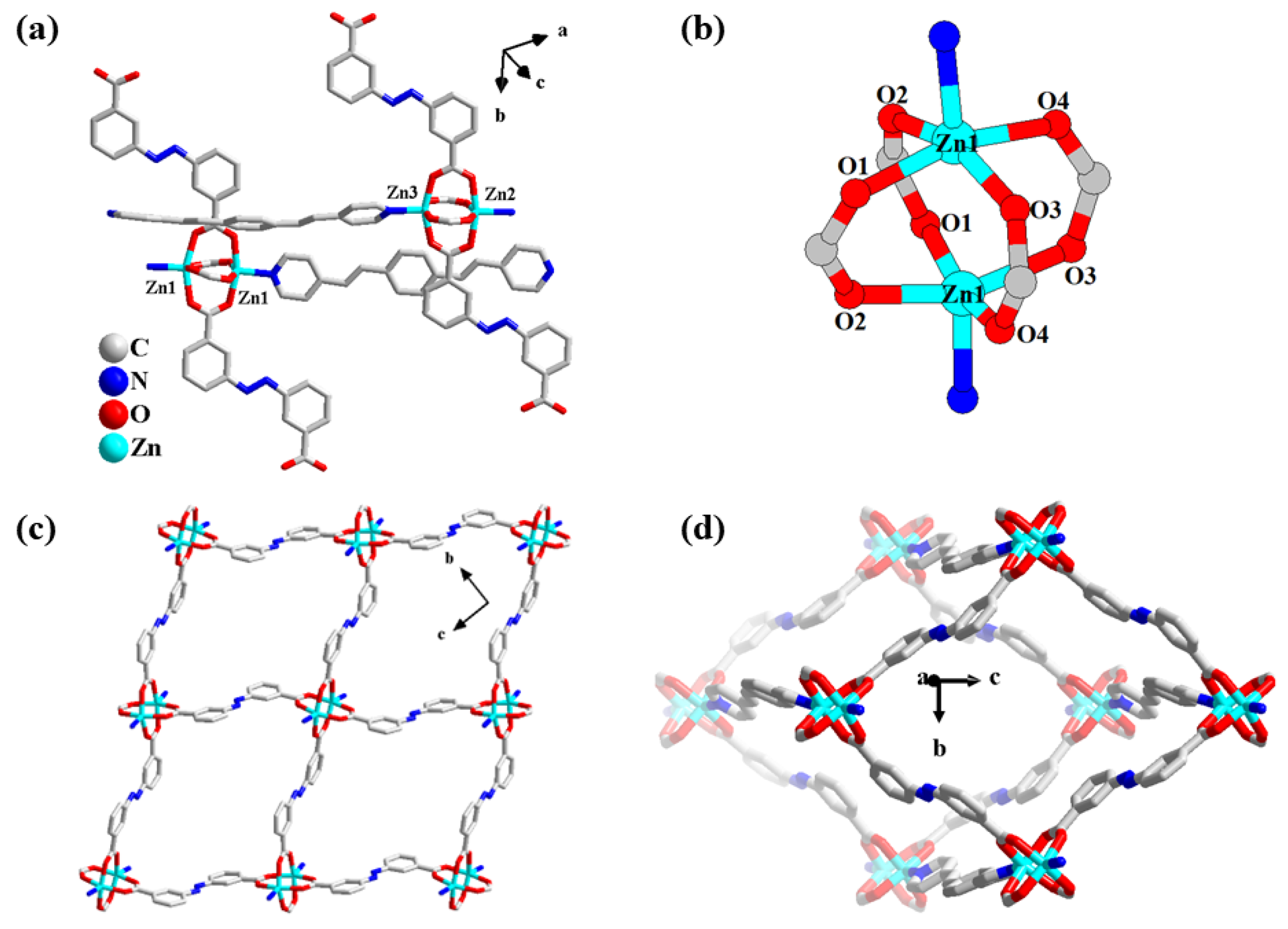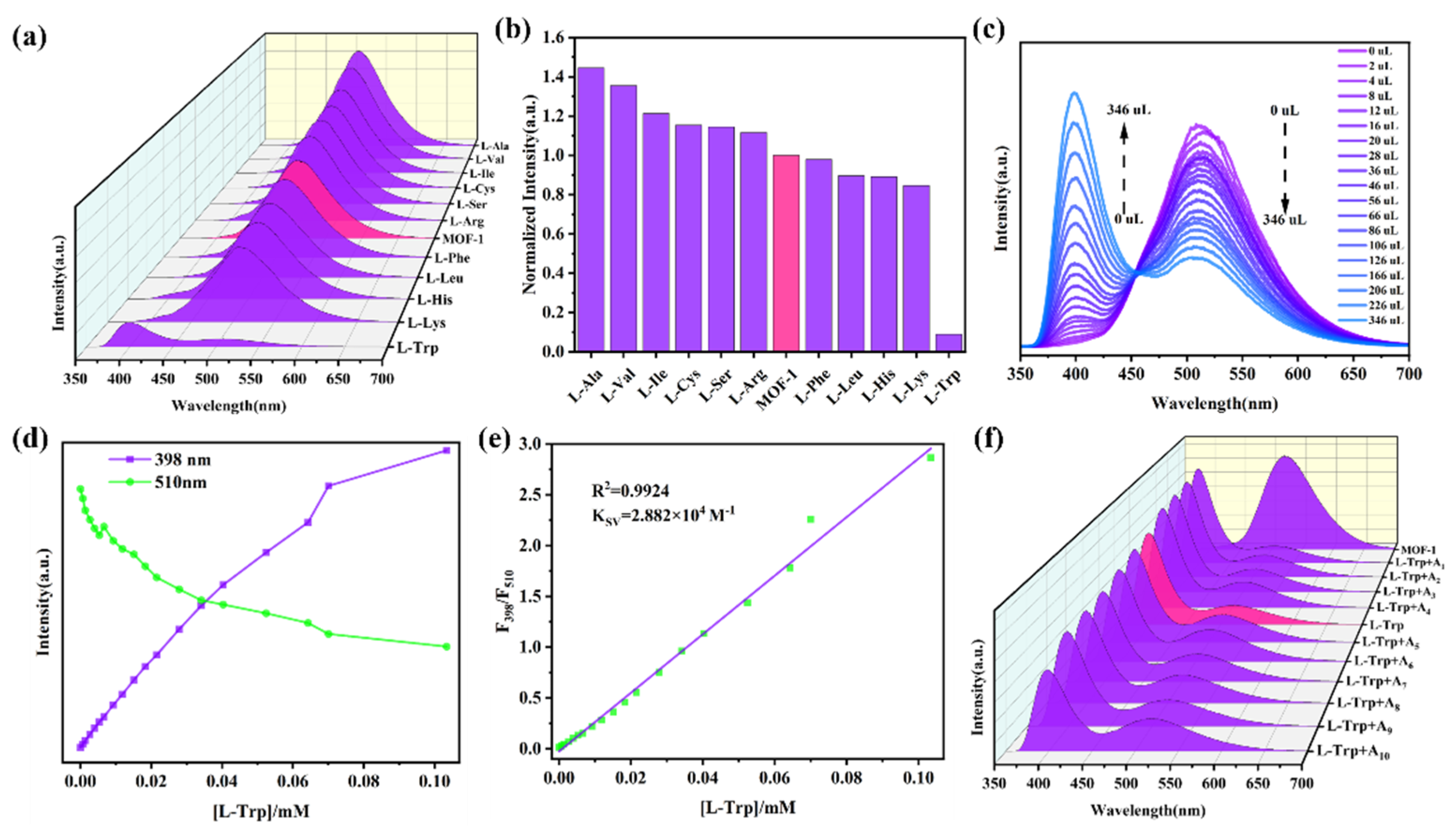Studying Fluorescence Sensing of Acetone and Tryptophan and Antibacterial Properties Based on Zinc-Based Triple Interpenetrating Metal–Organic Skeletons
Abstract
:1. Introduction
2. Results
2.1. Description of the MOF-1 and MOF-2 Crystal Structure
2.2. Phase Purity and Stability of MOF-1 and MOF-2
2.3. XPS Analysis
2.4. SEM and EDS Analysis
2.5. Solvent Sensing Tests
2.6. Amino Acid Sensing Tests
2.7. Luminescence Sensing Mechanism
2.8. Antibacterial Properties of MOF-1 and MOF-2
3. Experiment
3.1. Synthesis of [Zn6(1,4-bpeb)4(IPA)6(H2O)]n (MOF-1) [35]
3.2. Synthesis of {[Zn3(1,4-bpeb)1.5(DDBA)3]n·2DMF} (MOF-2)
3.3. Detection of Acetone Test
3.4. Detection of L-Trp Test
3.5. Antibacterial Performance Test
3.5.1. Preparation of LB Liquid Medium
3.5.2. Preparation of Bacterial Suspension
3.5.3. Determination of Bacteriostatic Zone of MOFs
3.5.4. Determination of Minimum Bacteriostatic Concentration of MOFs
3.5.5. Determination of Bacteriostatic Dynamic Curve of MOFs
4. Conclusions
Supplementary Materials
Author Contributions
Funding
Institutional Review Board Statement
Informed Consent Statement
Data Availability Statement
Conflicts of Interest
Sample Availability
References
- Perez-Gonzalez, A.; Muñoz-Rugeles, L.; Alvarez-Idaboy, J.R. Tryptophan: Antioxidant or target of oxidative stress? A quantum chemistry elucidation. RSC Adv. 2014, 4, 56128–56131. [Google Scholar] [CrossRef]
- Wang, L.; Yang, R.; Li, J.; Qu, L. A highly selective and sensitive electrochemical sensor for tryptophan based on the excellent surface adsorption and electrochemical properties of PSS functionalized graphene. Talanta 2019, 196, 309–316. [Google Scholar] [CrossRef]
- Zhu, X.; Zhao, J.; Dai, F.; Xu, W.; Chen, L.; Xiao, X.; Zhang, C. Selective recognition of tryptophan by a methylpillar [5] arene-based supramolecular fuorescent probe. Spectrochim. Acta Part A 2021, 250, 119381. [Google Scholar] [CrossRef]
- Zhang, C.; Li, L.; Hou, L.; Chen, W. Fabrication of Co3O4 nanowires assembled on the surface of hollow carbon spheres for acetone gas sensing. Sens. Actuators B 2019, 291, 130–140. [Google Scholar] [CrossRef]
- Yang, Y.; Xu, S.; Gai, Y.; Zhang, B.; Chen, L. Recent Progresses in Lanthanide Metal-Organic Frameworks (Ln-MOFs) as Chemical Sensors for Ions, Antibiotics and Amino Acids. Chin. J. Struct. Chem. 2022, 41, 2211045–2211070. [Google Scholar]
- Salomé Veiga, A.; Schneider, J. Antimicrobial hydrogels for the treatment of infection. Pept. Sci. 2013, 100, 637–644. [Google Scholar] [CrossRef]
- Liu, Z.; Ye, J.; Rauf, A.; Zhang, S.; Wang, G.; Shi, S.; Ning, G. A flexible fibrous membrane based on copper(II) metal-organic framework/poly(lactic acid) composites with superior antibacterial performance. Biomater. Sci. 2021, 9, 3851–3859. [Google Scholar] [CrossRef]
- Li, X.; Zheng, H.; Chen, J.; Xu, M.; Bai, Y.; Liu, T. MIL-101 (Fe) @Ag Rapid Synergistic Antimicrobial and Biosafety Evaluation of Nanomaterials. Molecules 2022, 27, 3497. [Google Scholar] [CrossRef]
- Zhang, W.; Ye, G.; Liao, D.; Chen, X.; Lu, C.; Nezamzadeh-Ejhieh, A.; Khan, M.; Liu, J.; Pan, Y.; Dai, Z. Recent Advances of Silver-Based Coordination Polymers on Antibacterial Applications. Molecules 2022, 27, 7166. [Google Scholar] [CrossRef] [PubMed]
- Polash, S.; Khare, T.; Kumar, V.; Shukla, R. Prospects of Exploring the Metal−Organic Framework for Combating Antimicrobial Resistance. ACS Appl. Bio Mater. 2021, 4, 8060–8079. [Google Scholar] [CrossRef] [PubMed]
- Luan, L.; Du, L.; Shi, W.; Li, Y.; Zhang, Q. Photodynamic Inactivation of Bacteria and Biofilms with Benzoselenadiazole-Doped Metal-Organic Frameworks. Molecules 2022, 27, 8908. [Google Scholar] [CrossRef] [PubMed]
- Wu, X.; Liu, M.; Guo, H.; Ying, S.; Chen, Z. Polyoxovanadate-based MOFs Microsphere Constructed from 3-D Discrete Nano-sheets as Supercapacitor. Chin. J. Struct. Chem. 2021, 40, 994–998. [Google Scholar]
- Li, Z.; He, L.; Guo, Y.; Luo, M.; Lin, Q. A Stable Luminescent MOF Constructed by Bis-(4-pyridyl)thiazolo [5,4-d] thiazole Containing Multi-electron Donor-acceptor Core. Chin. J. Struct. Chem. 2021, 40, 610–614. [Google Scholar]
- Connolly, B.; Madden, D.; Wheatley, A.; Fairen-Jimenez, D. Shaping the future of fuel: Monolithic metal-organic frameworks for high-density gas storage. J. Am. Chem. Soc. 2020, 142, 8541–8549. [Google Scholar] [CrossRef] [PubMed]
- Fan, L.; Zhao, D.; Zhang, H.; Wang, F.; Li, B.; Yang, L.; Zhang, X. A hydrolytically stable amino-functionalized Zinc (II) metal-organic framework containing nanocages for selective gas adsorption and luminescent sensing. Microporous Mesoporous Mat. 2021, 326, 111396. [Google Scholar] [CrossRef]
- Hu, Z.; Khurana, M.; Seah, Y.; Zhang, M.; Guo, Z.; Zhao, D. Ionized Zr-MOFs for highly efficient post-combustion CO2 capture. Chem. Eng. Sci. 2015, 124, 61–69. [Google Scholar] [CrossRef]
- Dai, Y.; Xiong, Y. Control of selectivity in organic synthesis via heterogeneous photocatalysis under visible light. Nano Res. Energy 2022, 1, e9120006. [Google Scholar] [CrossRef]
- Wei, Y.; Zhang, M.; Zou, R.; Xu, Q. Metal-organic framework-based catalysts with single metal sites. Chem. Rev. 2020, 120, 12089–12174. [Google Scholar] [CrossRef] [PubMed]
- Luo, H.; Zeng, Z.; Zeng, G.; Zhang, C.; Xiao, R.; Huang, D.; Tian, S. Recent progress on metal-organic frameworks based-and derived-photocatalysts for water splitting. Chem. Eng. J. 2020, 383, 123196. [Google Scholar] [CrossRef]
- Zhao, S.; Gu, J. Syntheses, Structures and Catalytic Properties of Two Mn(II) and Cd(II) Coordination Polymers through in Situ Ligand Reaction. Chin. J. Struct. Chem. 2021, 40, 785–796. [Google Scholar]
- Lazaro, I.; Forgan, R. Application of zirconium MOFs in drug delivery and biomedicine. Coord. Chem. Rev. 2019, 380, 230–259. [Google Scholar] [CrossRef]
- Zheng, G.; Pastoriza-Santos, I.; Pérez-Juste, J.; Liz-Marzán, L. Plasmonic metal-organic frameworks. SmartMat 2021, 21, 446–465. [Google Scholar] [CrossRef]
- Wang, H.; Wang, Y.; Ding, Y. Development of biological metal-organic frameworks designed for biomedical applications: From bio-sensing/bio-imaging to disease treatment. Nanoscale Adv. 2020, 2, 3788–3797. [Google Scholar] [CrossRef] [PubMed]
- Wang, H. Metal-organic frameworks for biosensing and bioimaging applications. Coord. Chem. Rev. 2017, 349, 139–155. [Google Scholar] [CrossRef]
- Fang, X.; Zong, B.; Mao, S. Metal-organic framework-based sensors for environmental contaminant sensing. Nano-Micro Lett. 2018, 10, 64. [Google Scholar] [CrossRef]
- Yao, S.; Liu, S.; Tian, X.; Zheng, T.; Cao, C.; Niu, C.; Wen, H. A ZnII-based metal-organic framework with a rare tcj topology as a turn-on fluorescent sensor for acetylacetone. Inorg. Chem. 2019, 58, 3578–3581. [Google Scholar] [CrossRef]
- Fan, C.; Zhu, B.; Zhang, X.; Bi, C.; Zhang, D.; Zong, Z.; Fan, Y. Highly stable Acid-induced emission-enhancing Cd-MOFs: Synthesis, characterization, and detection of glutamic acid in water and Fe ions in acid. Inorg. Chem. 2021, 60, 6339–6348. [Google Scholar] [CrossRef]
- Yang, F.; Xu, G.; Dou, Y.; Wang, B.; Zhang, H.; Wu, H.; Chen, B. A flexible metal-organic framework with a high density of sulfonic acid sites for proton conduction. Nat. Energy 2017, 2, 877–883. [Google Scholar] [CrossRef]
- Zhang, X.; Wang, B.; Alsalme, A.; Xiang, S.; Zhang, Z.; Chen, B. Design and applications of water-stable metal-organic frameworks: Status and challenges. Coord. Chem. Rev. 2020, 423, 213507. [Google Scholar] [CrossRef]
- Yao, Y.; Zhou, Y.; Zhu, T.; Gao, T.; Li, H.; Yan, P. Eu(III) Tetrahedron Cage as a Luminescent Chemosensor for Rapidly Reversible and Turn-On Detection of Volatile Amine/NH3. ACS Appl. Mater. Interfaces 2020, 12, 15338–15347. [Google Scholar] [CrossRef]
- Zhao, Y.; Wan, M.; Bai, J.; Zeng, H.; Lu, W.; Li, D. pH-Modulated luminescence switching in a Eu-MOF: Rapid detection of acidic amino acids. J. Mater. Chem. A 2019, 7, 11127–11133. [Google Scholar] [CrossRef]
- Yang, A.; Hou, S.; Shi, Y.; Yang, G.; Qin, D.; Zhao, B. Stable Lanthanide-Organic Framework as a Luminescent Probe to Detect Both Histidine and Aspartic Acid in Water. Inorg. Chem. 2019, 58, 6356–6362. [Google Scholar] [CrossRef]
- Abd, E.; Nassar, H.; Khidr, A.; Zaki, K. Antimicrobial activities of green synthesized Ag nanoparticles@ Ni-MOF nanosheets. J. Inorg. Organomet. Polym. Mater. 2018, 28, 2791–2798. [Google Scholar]
- Alavijeh, R.; Beheshti, S.; Akhbari, K.; Morsali, A. Investigation of reasons for metal-organic framework’s antibacterial activities. Polyhedron 2018, 156, 257–278. [Google Scholar] [CrossRef]
- Liu, D.; Ren, Z.; Li, H.; Chen, Y.; Wang, J.; Zhang, Y.; Lang, J. pH-dependent solvothermal formation of two different 3D multiple interpenetrating nets from the same components of Zn(NO3)2, 1,3-benzenedicarboxylate and 1,4-bis [2-(4-pyridyl)ethenyl]benzene. CrystEngComm 2010, 12, 1912–1919. [Google Scholar] [CrossRef]
- Chen, X.; Tan, G.; Chen, W.; Chang, J.; Yue, Y.; Li, Y.; Feng, X. A zinc-based metal-organic framework with a triazine moiety: Effective detection of antibiotics and photodegradation dyes in aqueous solution. CrystEngComm 2023, 25, 1965–1975. [Google Scholar] [CrossRef]
- Han, M.; Wen, G.; Dong, W.; Zhou, Z.; Wu, Y.; Zhao, J.; Bu, X. A heterometallic sodium-europium-cluster-based metal-organic framework as a versatile and water-stable chemosensor for antibiotics and explosives. J. Mater. Chem. C 2017, 5, 8469–8474. [Google Scholar] [CrossRef]
- Yin, J.; Li, W.; Li, W.; Liu, L.; Zhao, D.; Liu, X.; Hu, T.; Fan, L. Heterometallic ZnHoMOF as a Dual-Responsive Luminescence Sensor for Efficient Detection of Hippuric Acid Biomarker and Nitrofuran Antibiotics. Molecules 2023, 28, 6274. [Google Scholar] [CrossRef]
- Li, W.; Zhao, D.; Li, W.; Wen, R.; Liu, X.; Liu, L.; Li, T.; Fan, L. Chemorobust dye-encapsulated framework as dual-emission self-calibrating ratiometric sensor for intelligent detection of toluene exposure biomarker in urine. Spectrochim. Acta A 2023, 296, 122637. [Google Scholar] [CrossRef]
- Zhao, Y.; Wang, Y.; Wang, N.; Zheng, P.; Fu, H.; Han, M.; Wang, L. Tetraphenylethylene-Decorated Metal-Organic Frameworks as Energy-Transfer Platform for the Detection of Nitro-Antibiotics and White-Light Emission. Inorg. Chem. 2019, 58, 12700–12706. [Google Scholar] [CrossRef]
- Zhu, S.; Yan, B. A Novel Sensitive Fluorescent Probe of S2O82- and Fe3+ based on Covalent Post-Functionalization of a Zirconium (iv) Metal–Organic Framework. Dalton Trans. 2018, 47, 11586–11592. [Google Scholar] [CrossRef] [PubMed]
- Jo, J.; Kim, H.; Huh, S.; Kim, Y.; Lee, D. Antibacterial activities of Cu-MOFs containing glutarates and bipyridyl ligands. Dalton Trans. 2019, 48, 8084–8093. [Google Scholar] [CrossRef] [PubMed]
- Lelouche, S.; Albentosa-González, L.; Clemente-Casares, P.; Biglione, C.; Rodríguez-Diéguez, A.; Barrilero, J.; García-Martínez, J.; Horcajada, P. Antibacterial Cu or Zn-MOFs Based on the 1,3,5-Tris-(styryl)benzene Tricarboxylate. Nanomaterials 2023, 13, 2294. [Google Scholar] [CrossRef]
- Wu, P.; Jiang, M.; Hu, X.; Wang, J.; He, G.; Shi, Y.; Li, Y.; Liu, W.; Wang, J. Amide-containing luminescent metal-organic complexes as bifunctional materials for selective sensing of amino acids and reaction prompting. RSC Adv. 2016, 6, 27944–27951. [Google Scholar] [CrossRef]
- Weng, H.; Yan, B. A sliver ion fabricated lanthanide complex as a luminescent sensor for aspartic acid. Sens. Actuat. B Chem. 2017, 253, 1006–1011. [Google Scholar] [CrossRef]
- Abdelhamid, H.; Bermejo-Gomez, A.; Martin-Matute, B.; Zou, X. A water-stable lanthanide metal-organic framework for fluorimetric detection of ferric ions and tryptophan. Microchim. Acta 2017, 184, 3363–3371. [Google Scholar] [CrossRef]
- Zhang, J.; Huang, Y.; Yue, D.; Cui, Y.; Yang, Y.; Qian, G. A luminescent turnup metal-organic framework sensor for tryptophan based on singlet-singlet Förster energy transfer. J. Mater. Chem. B. 2018, 6, 5174–5180. [Google Scholar] [CrossRef]
- Wang, J.; Liu, Y.; Jiang, M.; Li, Y.; Xia, L.; Wu, P. Aldehyde-functionalized metalorganic frameworks for selective sensing of homocysteine over Cys, GSH and other natural amino acids. Chem. Commun. 2018, 54, 1004–1007. [Google Scholar] [CrossRef]









Disclaimer/Publisher’s Note: The statements, opinions and data contained in all publications are solely those of the individual author(s) and contributor(s) and not of MDPI and/or the editor(s). MDPI and/or the editor(s) disclaim responsibility for any injury to people or property resulting from any ideas, methods, instructions or products referred to in the content. |
© 2023 by the authors. Licensee MDPI, Basel, Switzerland. This article is an open access article distributed under the terms and conditions of the Creative Commons Attribution (CC BY) license (https://creativecommons.org/licenses/by/4.0/).
Share and Cite
Yuan, C.; Qiao, Y.; Zhang, Z.; Chai, Y.; Zhang, X.; Dong, X.; Zhao, Y. Studying Fluorescence Sensing of Acetone and Tryptophan and Antibacterial Properties Based on Zinc-Based Triple Interpenetrating Metal–Organic Skeletons. Molecules 2023, 28, 7315. https://doi.org/10.3390/molecules28217315
Yuan C, Qiao Y, Zhang Z, Chai Y, Zhang X, Dong X, Zhao Y. Studying Fluorescence Sensing of Acetone and Tryptophan and Antibacterial Properties Based on Zinc-Based Triple Interpenetrating Metal–Organic Skeletons. Molecules. 2023; 28(21):7315. https://doi.org/10.3390/molecules28217315
Chicago/Turabian StyleYuan, Congying, Yidan Qiao, Zhaolei Zhang, Yinhang Chai, Xiaojun Zhang, Xiaojing Dong, and Ying Zhao. 2023. "Studying Fluorescence Sensing of Acetone and Tryptophan and Antibacterial Properties Based on Zinc-Based Triple Interpenetrating Metal–Organic Skeletons" Molecules 28, no. 21: 7315. https://doi.org/10.3390/molecules28217315
APA StyleYuan, C., Qiao, Y., Zhang, Z., Chai, Y., Zhang, X., Dong, X., & Zhao, Y. (2023). Studying Fluorescence Sensing of Acetone and Tryptophan and Antibacterial Properties Based on Zinc-Based Triple Interpenetrating Metal–Organic Skeletons. Molecules, 28(21), 7315. https://doi.org/10.3390/molecules28217315




